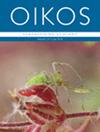地中海灌木林因干旱引起的死亡梯度上新生物群落的气候不平衡性
IF 3
2区 环境科学与生态学
Q2 ECOLOGY
引用次数: 0
摘要
植物与植物之间的良性互动(促进作用)可能会增强不那么适应当地宏观气候条件的物种的招募和建立。造成这种效应的一个主要原因是气候缓冲作用,这意味着生活在树冠下的植物的宏观气候条件与现有群落的气候要求(气候失衡)之间的不匹配加剧。在此,我们探讨了干旱引起的地中海灌木林冠层落叶对木本物种迁入的影响。我们分析了不同类型树冠落叶和植物与植物之间相互作用的气候失衡差异:促进、中性和抑制。气候失衡的估计是观测到的宏观气候与群落推断气候之间在多元环境空间中的欧氏距离。推断气候是通过物种分布获得的物种气候生态位中心坐标的平均值,并根据物种在每个群落中的相对丰度加权计算得出的。我们发现,生长在树冠下的新生物群落比生长在空隙中的群落表现出更高的气候不平衡性。生长在枯死和存活树冠下的促进新生物群落显示出最高的不平衡性,其次是生长在受影响树冠中部的群落。经历中性和抑制性相互作用的吸收群落的气候失衡不受冠层落叶的影响。这些研究结果表明,新加入群落的气候失衡是由促进-竞争平衡决定的。活的树冠提供气候缓冲,但也意味着竞争,而枯死的树冠可能提供一些结构性气候缓冲,但不意味着资源竞争。这些结果突出表明,将植物与植物之间的相互作用,特别是促进作用纳入其中,对于更好地预测植物群落对极端气候事件和气候变化的反应具有重要意义。本文章由计算机程序翻译,如有差异,请以英文原文为准。
Climatic disequilibrium of recruit communities across a drought‐induced die‐off gradient in Mediterranean shrubland
Positive plant–plant interactions (facilitation) may enhance the recruitment and establishment of species less adapted to local macroclimatic conditions. A major cause of this effect is climatic buffering, which implies an increased mismatch between the macroclimatic conditions and the climatic requirements of the existing community – climatic disequilibrium – of plants living under canopies. Here we explore the effect of drought‐induced defoliation of Mediterranean shrubland canopy on the recruitment of woody species. We analyzed the differences in the climatic disequilibrium across different categories of canopy defoliation and plant–plant interactions: facilitation, neutral and inhibition. Climatic disequilibrium was estimated as the Euclidean distance in the multivariate environmental space between observed macroclimate and community inferred climate. The inferred climate was calculated by averaging the coordinates of the species' climatic niche centroids, obtained from species distribution, weighted by the species' relative abundances in each community. We found that the recruiting community growing under canopy showed higher climatic disequilibrium than the community growing in the gaps. The facilitated recruiting community growing under dead and living canopy showed the highest disequilibrium, followed by the community growing under mid‐affected canopy. The climatic disequilibrium of the recruiting communities experiencing neutral and inhibited interaction was not affected by canopy defoliation. These findings indicate that the climatic disequilibrium of the recruiting community is determined by the facilitation–competition balance. Living canopy provides climatic buffering, but it also implies competition, while dead canopy may provide some structural climatic buffering, without implying competition for resources. These results highlight the relevance of incorporating plant–plant interactions, particularly facilitation, to better forecast plant community responses to extreme climate events and climate change.
求助全文
通过发布文献求助,成功后即可免费获取论文全文。
去求助
来源期刊

Oikos
环境科学-生态学
CiteScore
6.20
自引率
5.90%
发文量
152
审稿时长
6-12 weeks
期刊介绍:
Oikos publishes original and innovative research on all aspects of ecology, defined as organism-environment interactions at various spatiotemporal scales, so including macroecology and evolutionary ecology. Emphasis is on theoretical and empirical work aimed at generalization and synthesis across taxa, systems and ecological disciplines. Papers can contribute to new developments in ecology by reporting novel theory or critical empirical results, and "synthesis" can include developing new theory, tests of general hypotheses, or bringing together established or emerging areas of ecology. Confirming or extending the established literature, by for example showing results that are novel for a new taxon, or purely applied research, is given low priority.
 求助内容:
求助内容: 应助结果提醒方式:
应助结果提醒方式:


